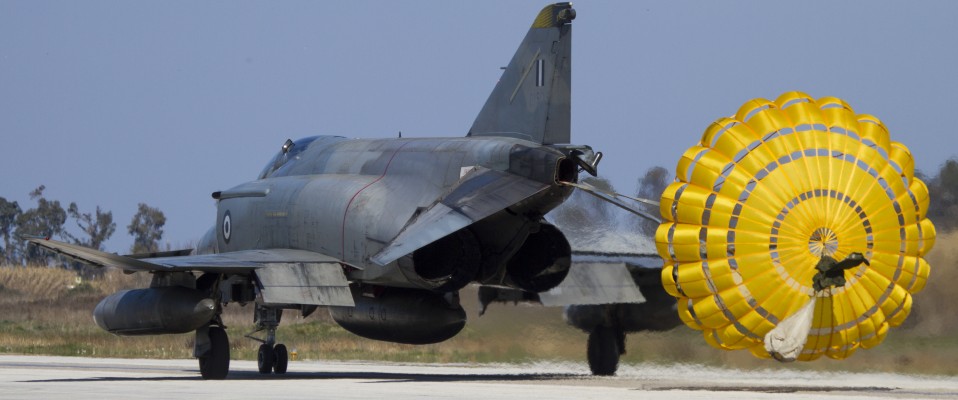HELLENIC PHANTOMS: The Phantom Lives!
Report and photos by George Karavantos
September 15, 2017
The 117 Combat Wing at Andravida is home to the legendary McDonnell Douglas F-4 Phantom fighters of the Hellenic Air Force (HAF). The Phantom might not be the most versatile and agile fighter in HAF service, but it remains an essential component of its Tactical Air Force planning. Today the HAF still maintains two front-line F-4E squadrons, while the aircraft is counting more than 40 years of service in Greece. The legend still lives on.
History of the Greek Phantoms
Peace Icarus I
The story of the Greek Phantoms dates back to 1972, when Greece signed the contract with United States and McDonnell Douglas for the purchase of 36 F-4E Phantom IIs. The program was named Peace Icarus Ι and included conversion training. At the time, Greece also ordered the French Mirage F-1CG and the American A-7 Corsair II. In the late 70s and lasting for over a decade, Greece was one of the few countries in Europe with so many advanced and modern aircraft in its inventory, and the superior air force in the Balkan region.
The new home for the Greek Phantoms was to become the 117 Combat Wing based at Andravida, near to Patra city. This airfield built in 1955 had only been used by an air detachment unit. Following the decision Andravida was completely renovated. The ageing infrastructure was reconstructed and new hangars were built for maintenance along with modern aircraft shelters.
The pilots selected to go the United States to receive training for the new aircraft were mostly F-84F pilots. The Republic F-84F Thunderstreak was the most numerous fighter but also the oldest type in HAF service and was being phased out. The initial squadrons destined to receive the modern F-4E were 338 and 339, both flew the F-84F in the strike mission.
The first 36 pilots went to the United States in December of 1973, while more followed in January of 1974. All HAF pilots were trained at Homestead AFB near Miami, Florida, where the 31st TFW was based equipped with F-4C and F-4D Phantoms.
The first aircraft destined for the HAF, serial number 72-1500 was first flown on 29 January 1974 from Lambert airport in St. Louis, with McDonnell Douglas test pilot E.D. Francis at the controls. The F-4E version first flown on 30 June 1967 was the most capable in the Phantom family up to then.
The F-4E version featured:
- J79-GE-17A upgraded engines with 17,900 lb of thrust with afterburning
- M61A1 six-barreled 20mm Gatling gun under the nose, with up to 640 rounds of ammunition
- AN/APQ-120 radar system, compared to the radar on the previous F-4s the more compact unit allowed room for the M61A1
- Fixed slat attached under the leading edge of the tailplane to provide improved control authority at high angles of attack (AOA)
- Seventh fuel cell in the tail of the airframe, above the engine nozzles
- Manual wing fold, instead of hydraulic fold
The F-4E for Greece included the implementation of leading edge slats that automatically extend when the aircraft’s AoA exceeds six degrees, and retract when the AoA returns to four degrees. This feature had first been introduced in mid-1972, but was also retrofitted to other F-4E aircraft.
The historical moment for the Greek Phantoms came on the afternoon of April 5th, 1974, when the first six aircraft touched down on runway 34 of Andravida. 15 days later, on Saturday 20 April, the ceremony took place for the establishment of the first Phantom Squadron, 339 Squadron.
Peace Icarus II
Due to increased tensions with Turkey, Greek officials decided to place a second order when deliveries from the first order were completed. On 22 October 1976, the Greek government announced the need for additional Phantoms. Finally on 16 July 1977 the second contract was signed under the name Peace Icarus II for the purchase of 18 F-4E along with 8 RF-4E photoreconnaissance versions. These were delivered in 1978-1979, completing the Greek Phantom fleet originally procured from the manufacturer for the HAF.
The RF-4Es went to 348 Squadron “Eyes” of the 110 Combat Wing at Larissa. The Peace Icarus II batch of F-4E fighters enabled the establishment of a third Phantom unit, 337 Squadron ‘Ghost’ also based at Larissa. This squadron assumed primary responsibility for the defense of the central and northern Aegean sea.
The serials of the F-4E aircraft from Peace Icarus I were 72-1500 to 72-1535. The Peace Icarus II F-4Es had serial numbers 77-1743 to 77-1760 and two other aircraft 74-1618 and 74-1619, which had originally been ordered to cover two losses that had already taken place. The RF-4E were 70357, 70358, and 71761 to 71766.
All HAF F-4E Phantoms were delivered to Greece in South East Asia color scheme (SEA, the “Vietnam” camouflage) with large light blue HAF roundels. Later many of them received an overall dark blue camouflage, named “Aegean Blue”. In the late 1990s, the current scheme dubbed “Aegean Ghost” started to be applied to the Greek Phantoms. The process was not completed for all of them, because retirement of the aircraft had begun.
Additional Phantoms
In July 1990 the US government offered 28 F-4E from the Indiana Air National Guard under the Southeastern Regional Agreement (SRA). As part of the deal, the US could continue operating of its own air bases in Greece for another 8 years. The first 9 aircraft came from the 131st Squadron of Missouri ANG, and arrived at Andravida on 3 August 1991. Upon their introduction, it was 338 Squadron that would receive all former USAF aircraft, while all existing Greek F-4s were allocated between 337 and 339 Squadron.
Despite the fact that the SRA F-4s were older production blocks (36 up to 41), they featured advanced Navigation and Weapon-Delivery System (NWDS), Airborne Video Tape Recorder (AVTR), Have Quick radios, improvements to the AN/APQ-120 radar for the air-to-ground role, and hey were equipped with “smokeless” upgraded J79 engines. All SRA Phantoms arrived in the standard USAF livery (American Hill Grey). Their serial numbers of these aircraft were:
– 67-0345, 0350, 0377,0381,
– 68-0318, 0361,0363, 0381, 0393, 0394, 0402, 0405, 0408, 0412, 0424, 0426, 0432, 0438, 0440, 0442, 0444, 0445, 0480, 0481, 0496, 0506, 0515, 0517.
The SRA F-4E aircraft were retired on 16 December 2005, when 337 Squadron temporarily ceased operations withdrawing all 28 of them in preparation for the arrival of the F-16C/D Block 52+ before resuming its role as lead interception unit of the northern Aegean.
Two years later 348 Squadron recce fleet was reinforced with 27 RF-4Es from the German Luftwaffe. Under NATO treaty, Germany granted a large number of RF-4E to Greece and Turkey which were being phased out of Luftwaffe service. The 27 aircraft for Greece started to arrive in the spring of 1993. Only 20 were taken into service and added to the 348 Squadron’s remaining 5 RF-4E (three had been lost in accidents), allowing the remainder of ageing RF-84F Thunderflashes to be finally retired. The rest of the German aircraft were used as spare parts source. The former Luftwaffe RF-4s all had the “Lizard” paint scheme. Later some received a different kind of “Lizard” paintjob and some were repainted in SEA scheme. The RF-4E retirement date is May 5, 2017.
It is worth mentioning that the HAF twice came very close to other agreements to obtain extra Phantoms. Once in 1987, when the US offered withdrawn F-4Ds, and on a second occasion when Great Britain was retiring its Phantom FGR Mk 2 (F-4M). Both offers were declined as it would be too expensive to maintain these different versions.
Peace Icarus 2000: ‘The Legend Is Back!’
After 23 years of defending the Aegean, the HAF decided to upgrade the F-4E Phantom II. In the early 1990s the search began for an upgrade program. The aircraft was still a capable weapon and procuring new fighters to defend the Aegean would be too costly. When the Greek government approved funding for the program two candidates, the German DASA and American Rockwell, offered their proposals. DASA had already upgraded the German F-4F, while Rockwell had the knowledge and know-how from the manufacturer McDonnell Douglas, which it had recently acquired.
The upgrade consisted of a life extension and the Avionics Upgrade Program mainly focused on replacing its electronic equipment and radar, centered on the BVR capability and modern AIM-120 missile. The number of the aircraft to be upgraded was 39, consisting of 29 Ρeace Ιcarus Ι and 10 Ρeace Ιcarus ΙΙ airframes.
DASA (later on EADS) won the contract, mainly thanks to its existing upgrade program for the F-4F. The contract, under the name Peace Icarus 2000, was signed on 11 August 1997, with deliveries planned to be completed by the end of 2000. The main systems supplier was the Israeli company Elbit, which had gained experience with its own upgrade program of the Israeli Phantoms.
Only one aircraft went to Germany to be used as testbed for the upgrade program. This aircraft was 72-1523 and it was nicknamed ‘Princess of Andravida’. The prototype first flew on 28 April 1999 and the test program took place at the facilities of DASA in Manching, near Munich, Germany. The Service Life Extension Program (SLEP) was carried out by Hellenic Aerospace Industry, which also upgraded the avionics on the other 38 aircraft.
One of the greatest tactical disadvantages of the Phantom was its smoky engines. The visibility of the smoke trail was greatly reduced by modification of the J79-GE-17A to -17C standard, replacing the ten combustion chambers with newer ones. Some of the Icarus 2000 Phantoms received existing -17C engines taken from the retired SRA F-4E Phantoms.
After 154 test flights and some fifteen months, 72-1523 returned to Greece, where it continued carrying out some weapon trials. After two years of long delays the first upgraded aircraft were ready by the end of 2002. On December 18th, 2002, the delivery ceremony for the first upgraded aircraft by Hellenic Aviation Industry was held at its facilities at Tanagra. At the end of the deliveries, the total number of upgraded aircraft was 36, due to three losses from accidents before completion of the program.
The F-4E AUP (Avionics Upgrade Program) Phantoms were all delivered to 117 Combat Wing at Andravida, all painted in the ‘Aegean Ghost’ scheme. With this upgrade the second generation fighter had become a very capable multi role fighter, which could oppose any third generation enemy aircraft.
The F-4E AUP consisted of the following new components:
- Hughes APG-65GY multi-mode radar; the same as on the F/A-18C Hornet
- Honeywell H-764G navigation system; a combination of LINS and GPS
- Datalink information system (DTS)
- NAVCOM radio altimeter ΑΝ/ΑΡΝ-232 CARΑ
- GEC Avionics CPU-143/A central air data computer
- Elbit Multi Mode Radar Command system
- Magnavox AN/ARC-164 Have Quick II communication system
- Collins AN/APN-153Y TACAN navaids
- Multi-functional colored displays in both cockpits
- EL-Op Heads Up Display (HUD)
- Data Transfer Unit
- Hands On Throttle and Stick (HOTAS) system
- Hazeltine AN/APX-113(V) IFF system (AFIDS)
The new IFF system is the most disguisable feature of the Ρeace Ιcarus 2000 Phantoms with its four “bird slicers” antennas on the nose.
Concerning its weaponry, the AIM-120 AMRAAM BVR missile replaced the original AIM-7 Sparrow. The aircraft can carry up to four AIM-120 AMRAAMs and can also be fitted with the modern dispenser missile AFDS, AGM-65A/B/G missiles, precision guided bombs such as the GBU-10/24 Paveway II/III, Mk 20 Rockeye II or other free fall bombs.
The weapons system officer’s (WSO) role evolved to match the multi-mode capabilities of the APG-65 radar. Furthermore, the use of the Litening pod is the WSO’s sole responsibility. An experienced WSO serves as the ‘brains’ of the tactical formation, providing regular situational awareness updates to the other crews to increase the probability of a kill in air-to-air missions or provide accurate attack parameters for air-to-ground missions. With the Litening II pod, the F-4E can also undertake non-traditional intelligence, surveillance and reconnaissance (NTISR) duties or designate targets for other aircraft carrying precision guided munitions.
Andravida Phantom Squadrons
The two Squadrons of the 117 Combat Wing each have a dual tactical role of Ground Attack and Interception, but their main roles are Ground Attack for 338 Squadron and Interception for 339 Squadron.
338 Fighter Bomber Squadron – Ares (Greek God of War)
The 338 Squadron was formed on 24 December 1952, at Elefsis AB, as 338 Fighter Bomber Squadron equipped with the F-84G Thunderjet. In May 1958 it was incorporated into the 115 CW at Souda AB until January 1960, when it was disbanded. It was reformed in August 1964 equipped with F-84F Thunderstreak.
When the F-4E Phantom II was delivered, 338 Squadron was reassigned in June 1974 to the 117CW at Andravida. In August 1991 the squadron’s aircraft were replaced by the F-4Es received under the Southeastern Regional Agreement (SRA).
The emblem of the squadron took its present form in 1974. The God has been “modernized” compared to the earlier emblem; instead of a spear he is holding a 2000 lb bomb. In the background there is the internationally recognized Spooky mascot of the F-4 Phantom. The inscription «H TAN H ΕΠΙ TAΣ» is the phrase Spartan mothers used to say to their sons as they handed over their shield for battle: «Return with the shield or (be carried) upon it».
339 All Weather Squadron – Ajax (the son of King Telamon of Salamis)
The 339 All Weather Interceptor Squadron formed on 7 July 1952 with the 112 CW at Elefsis AB. It was initially 339 Fighter Bomber Squadron and first equipped with the F-84G Thunderjet. After being redeployed to several other bases across Greece, in March 1971 it was finally assigned to the 117 Combat Wing at Andravida.
In April 1974 delivery of the F-4E Phantom II aircraft started re-equipping 339 Squadron. It received the first Peace Icarus 2000 upgraded aircraft in 2002 with the final delivery in October 2005.
Epilogue
The introduction of the F-4 in the Hellenic Air Force inventory in 1974 marked the beginning of a new era for the Hellenic Air Force. The new jet not only incorporated technological advances but also contributed to a major development in tactical air operations. At the time, the Phantom was the most modern aircraft in the HAF and at the same time a mature aircraft, battle-proven in US service in South-East Asia. With a crew of two, twin engines, good performance, large payload, BVR missiles, day and night, and capable of multiple roles, the Phantom presented a big leap for the HAF.
Today, Greece’s financial problems have impacted the military, but the Phantom maintains its role in the defence of Greek territory. The aircraft is usually synonymous with the old saying ‘drink, smoke and make noise’. Yet this jet is still capable of fighting against modern opponents.
THE LEGEND LIVES ON!
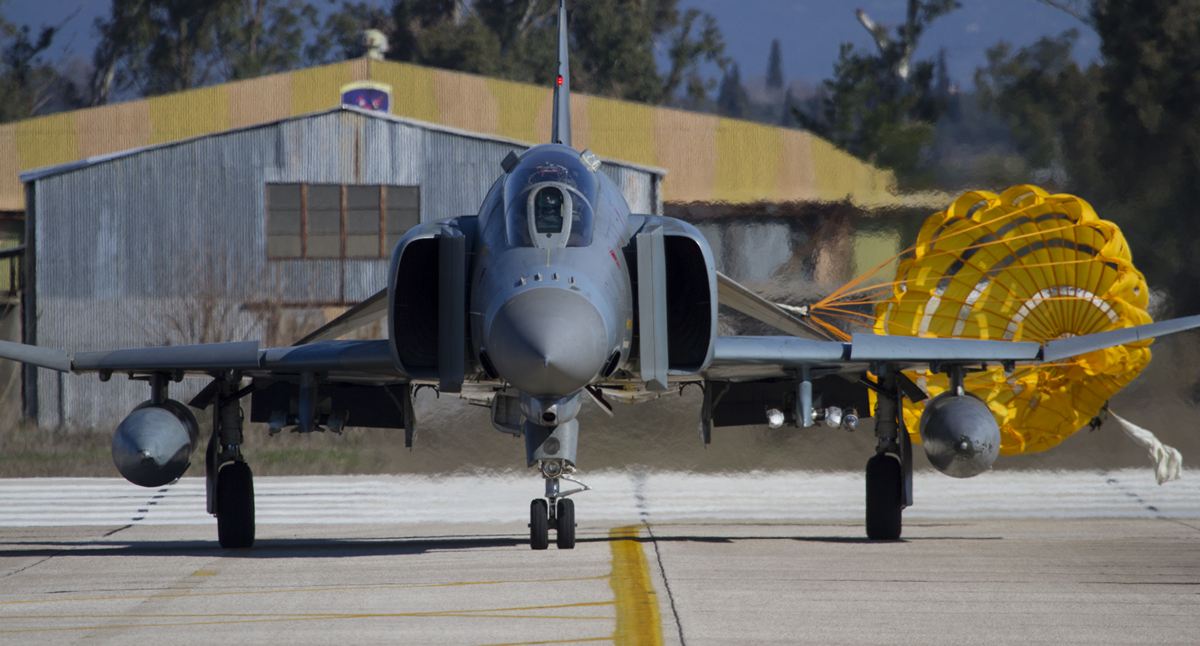
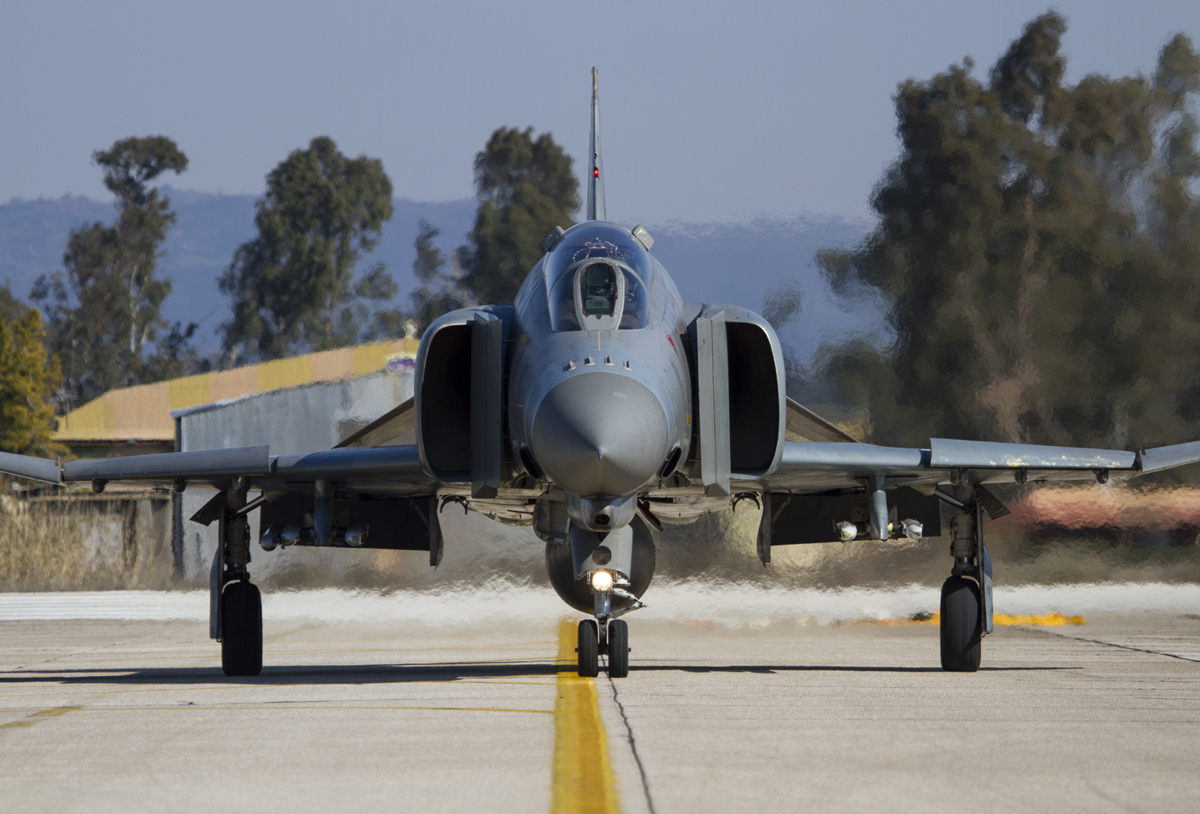
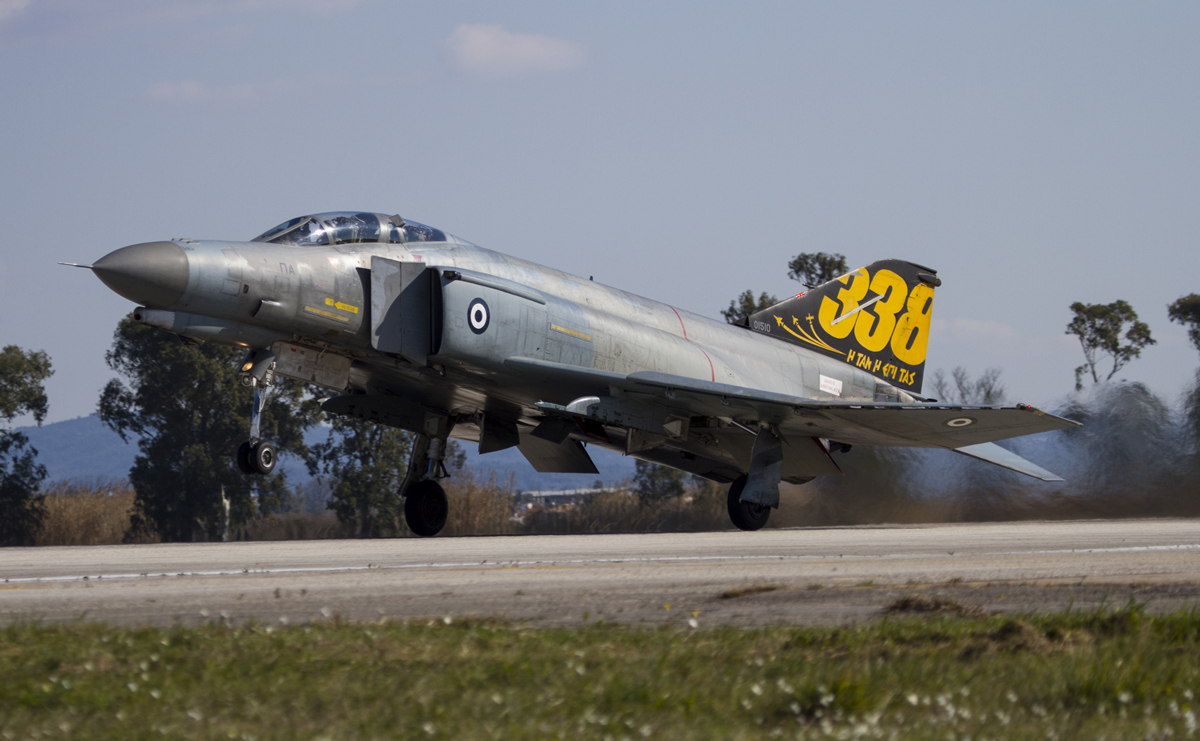
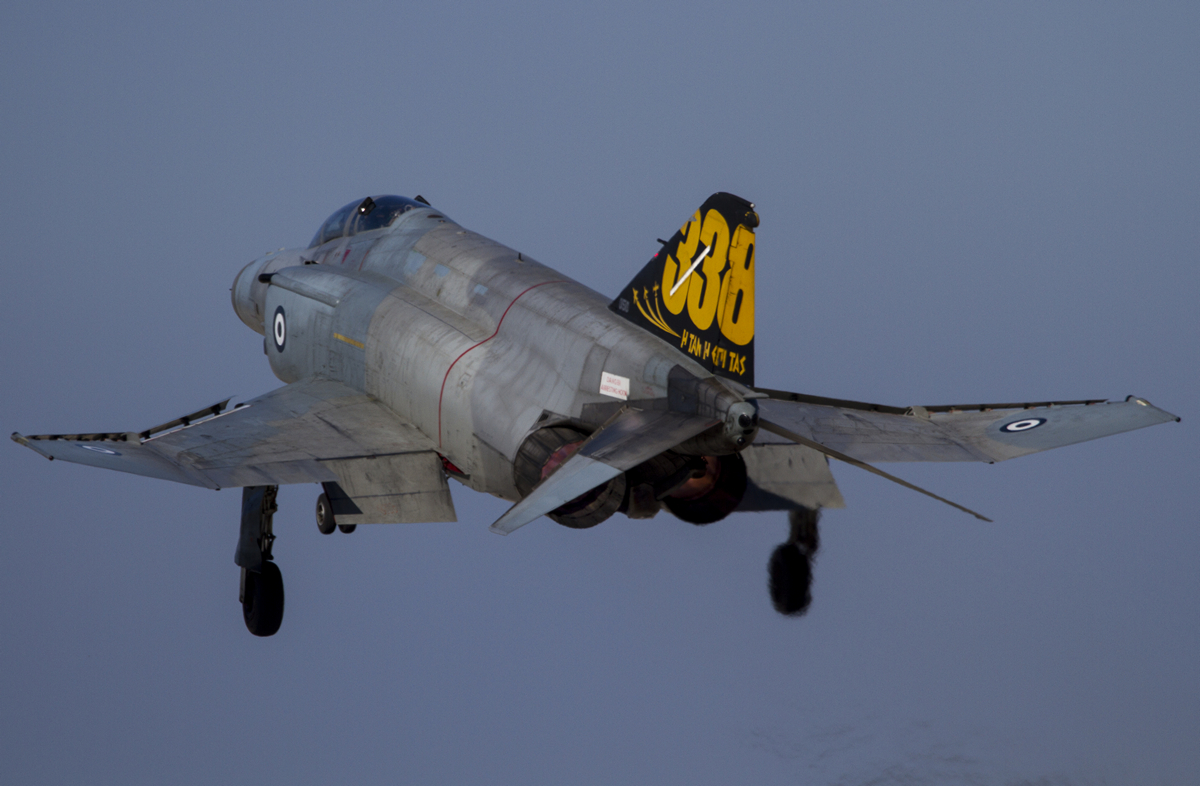
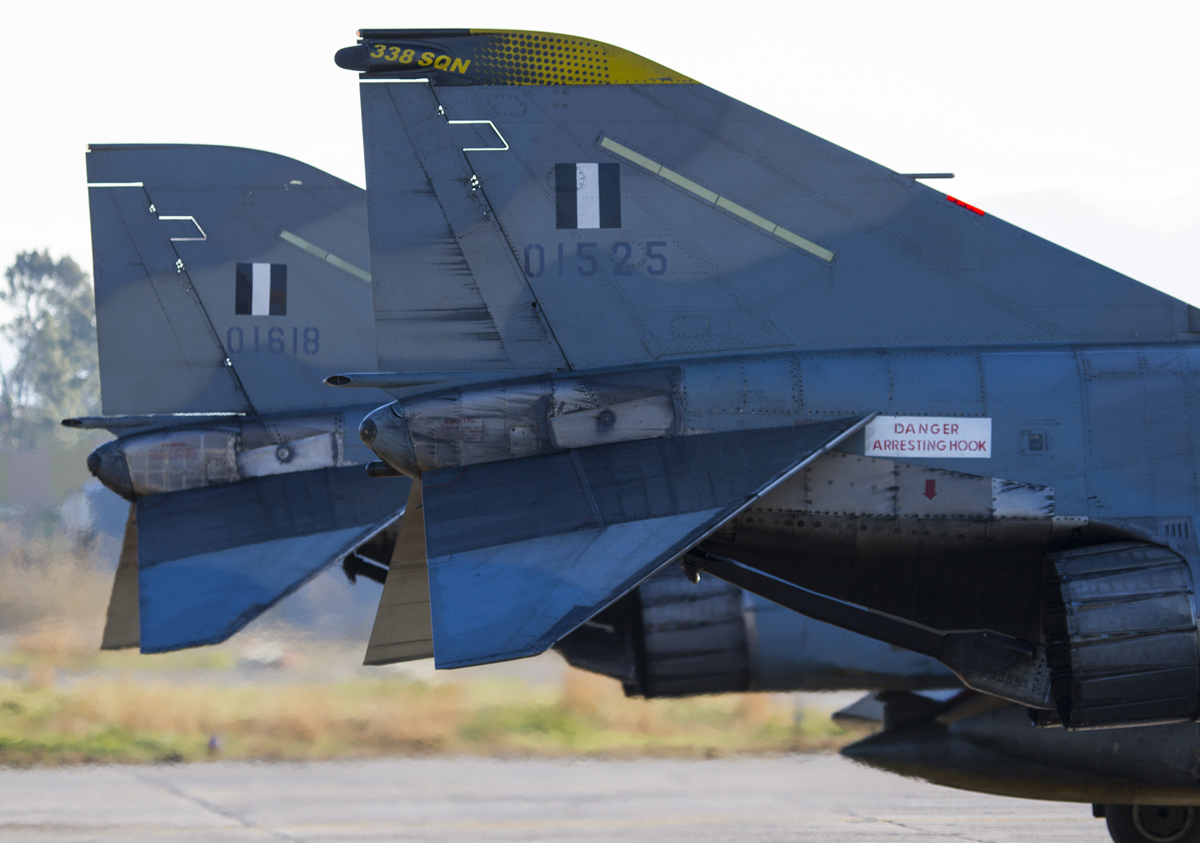
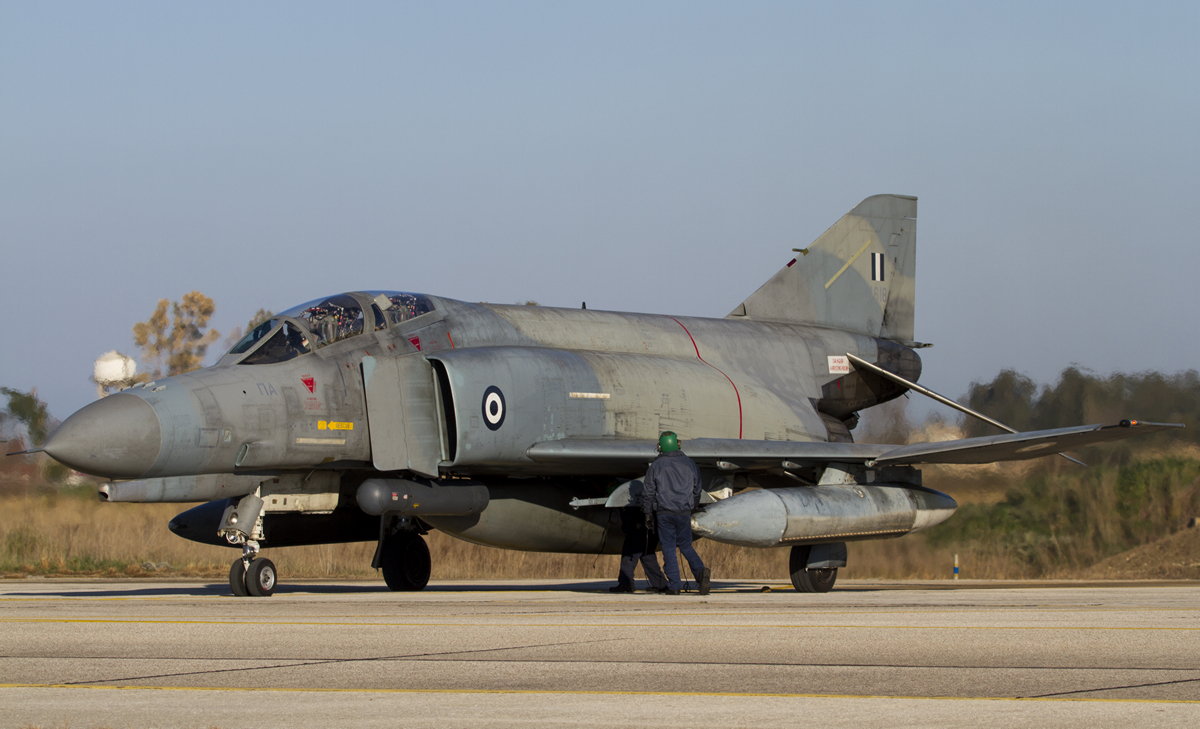
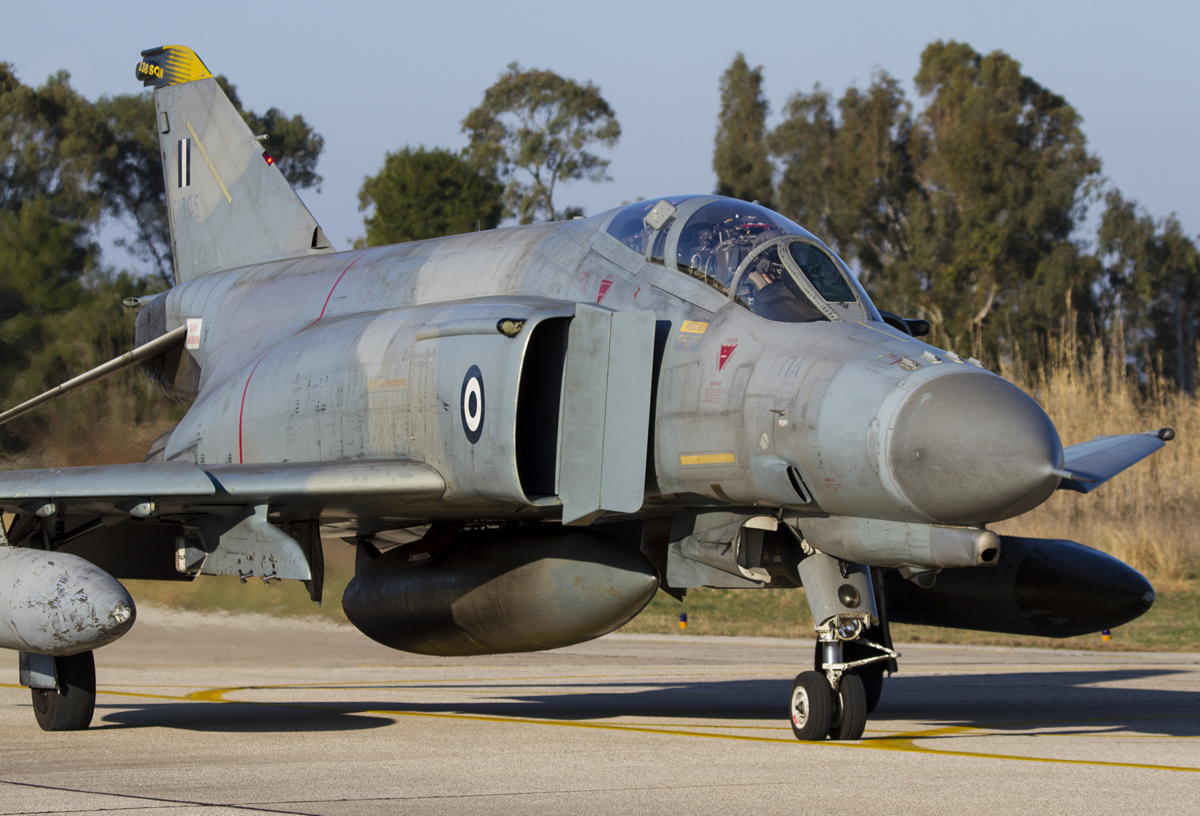
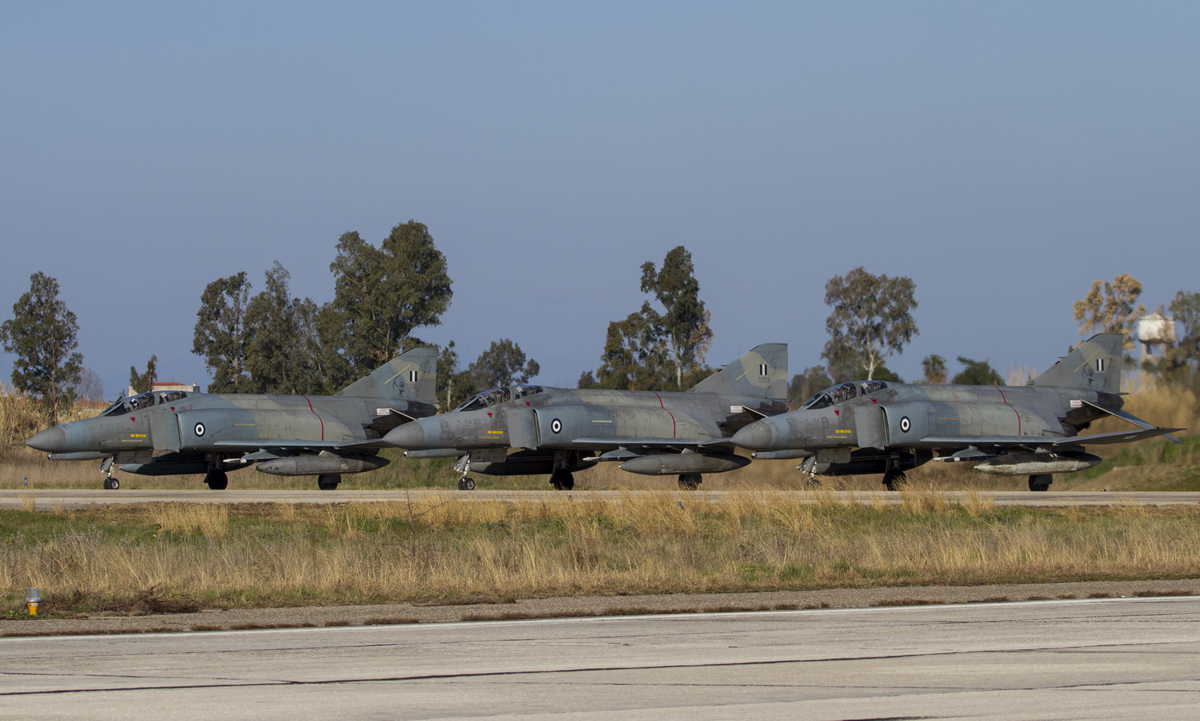
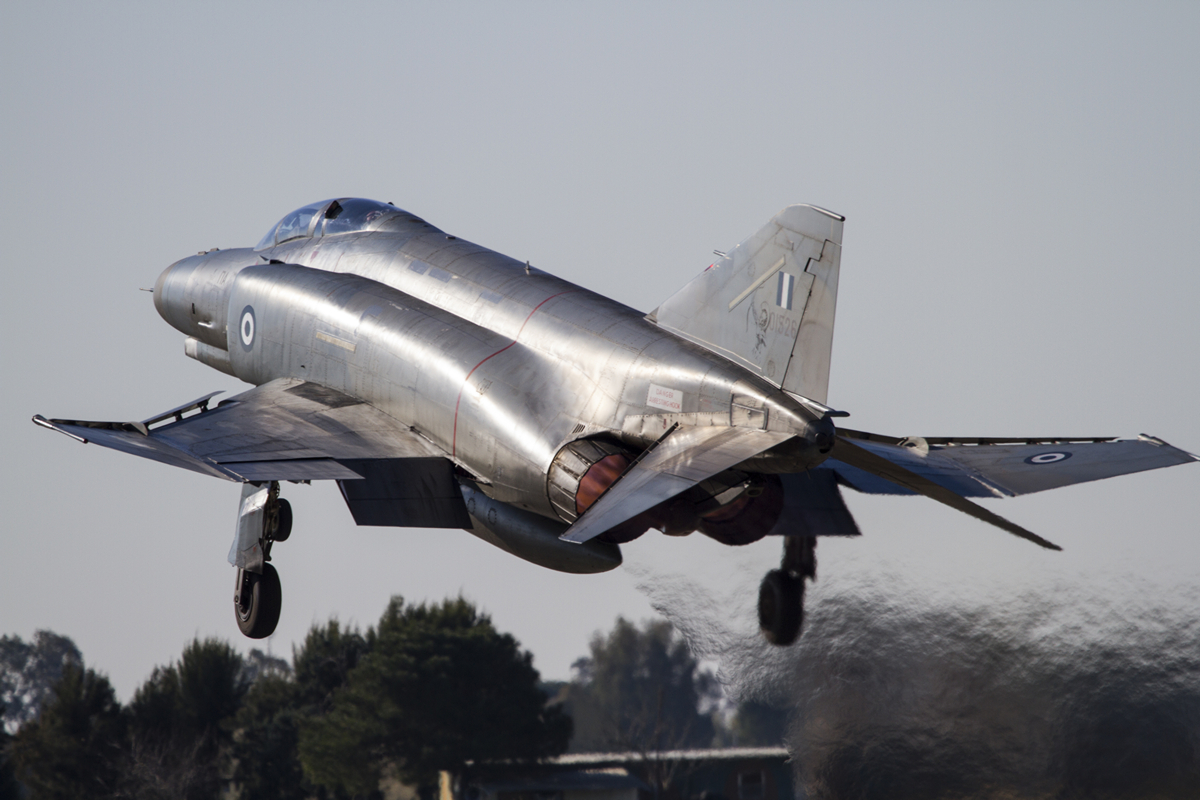
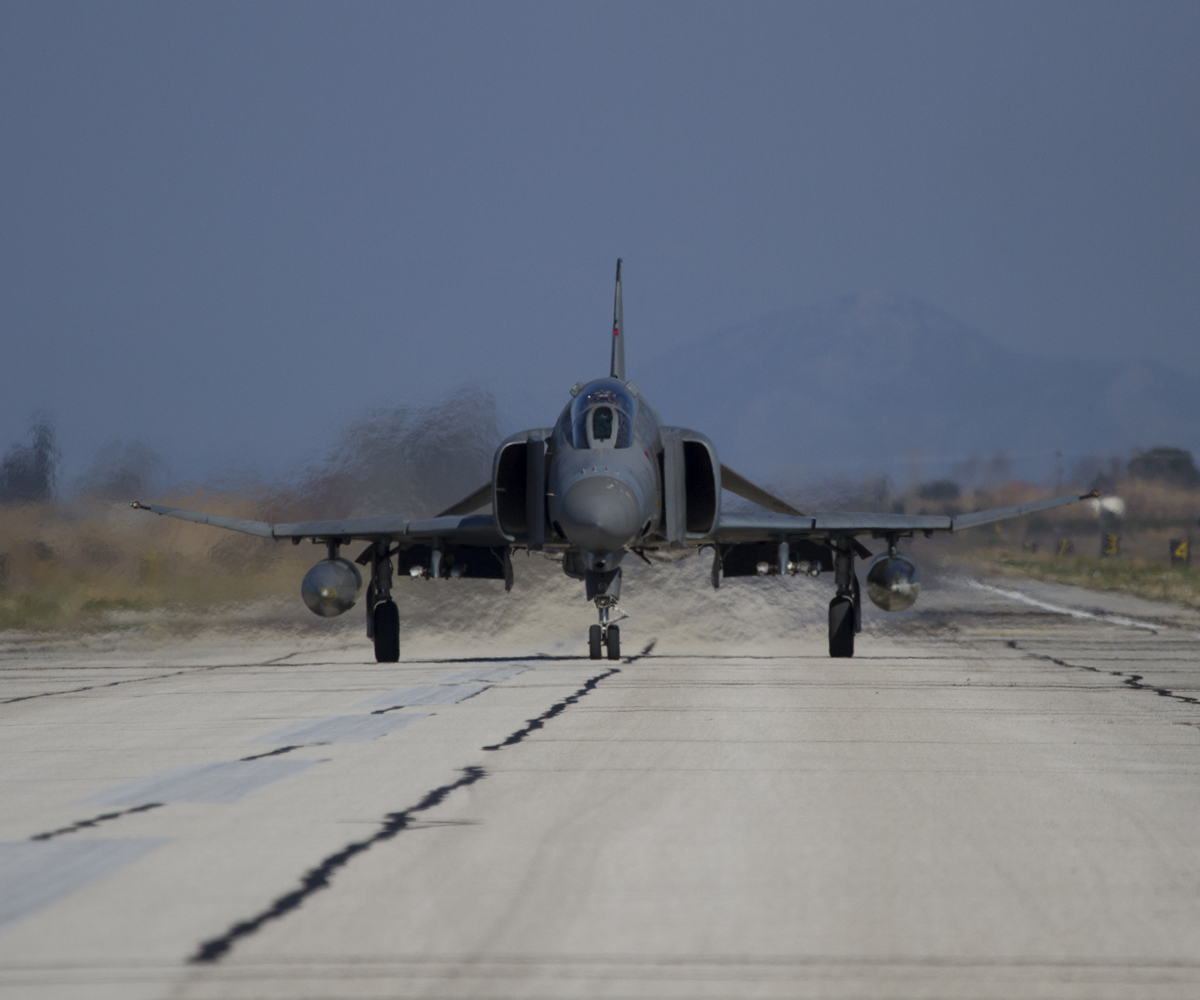
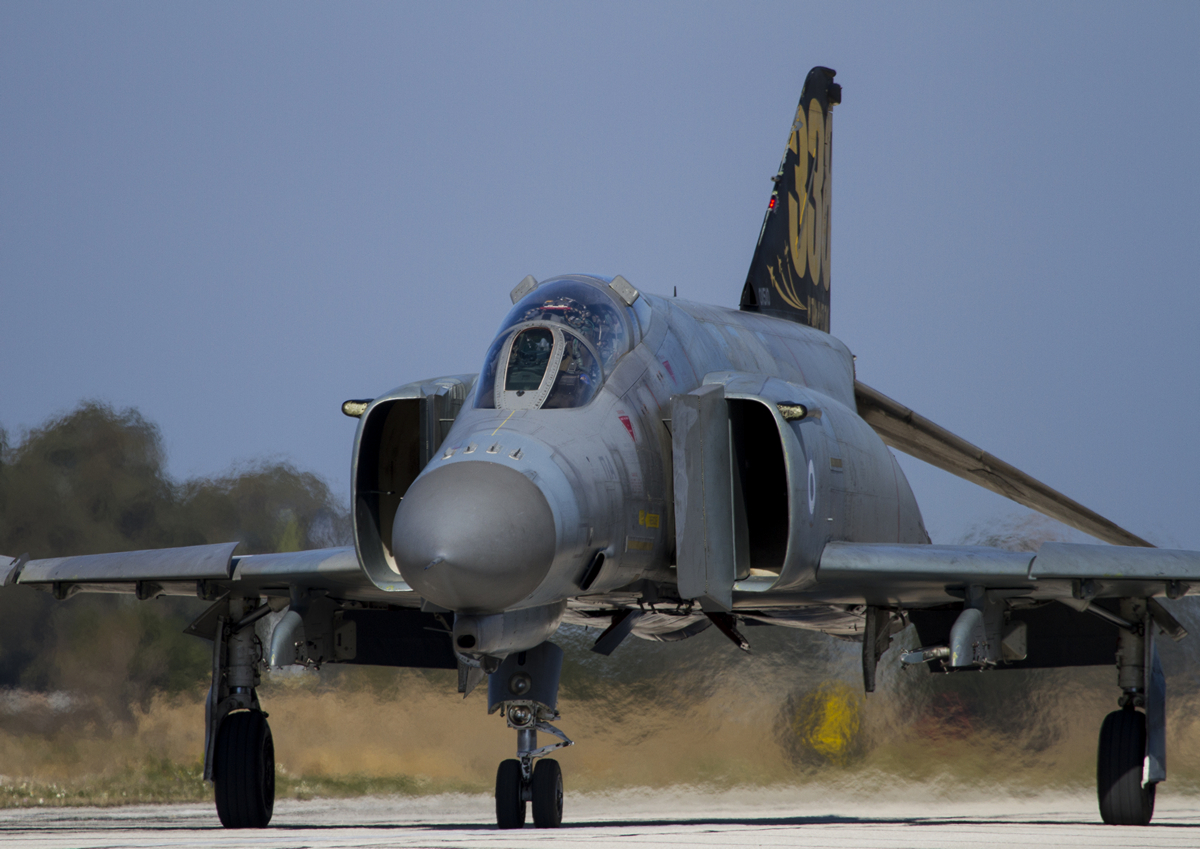
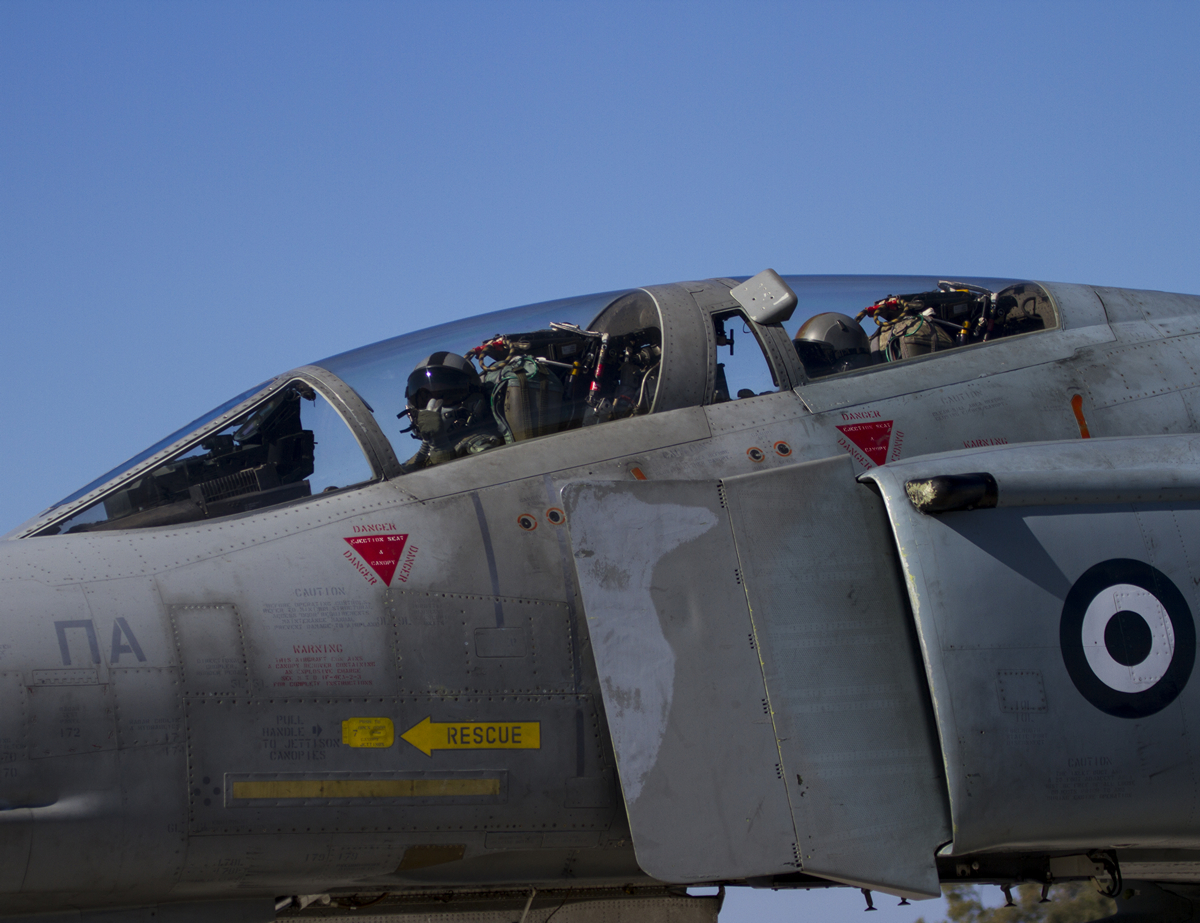
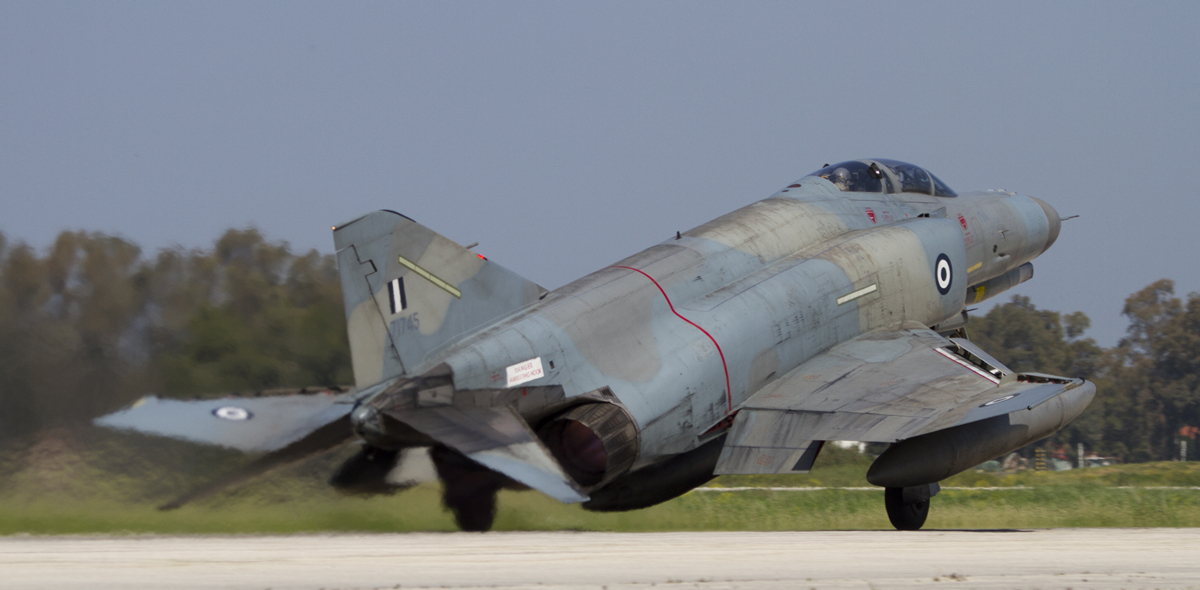
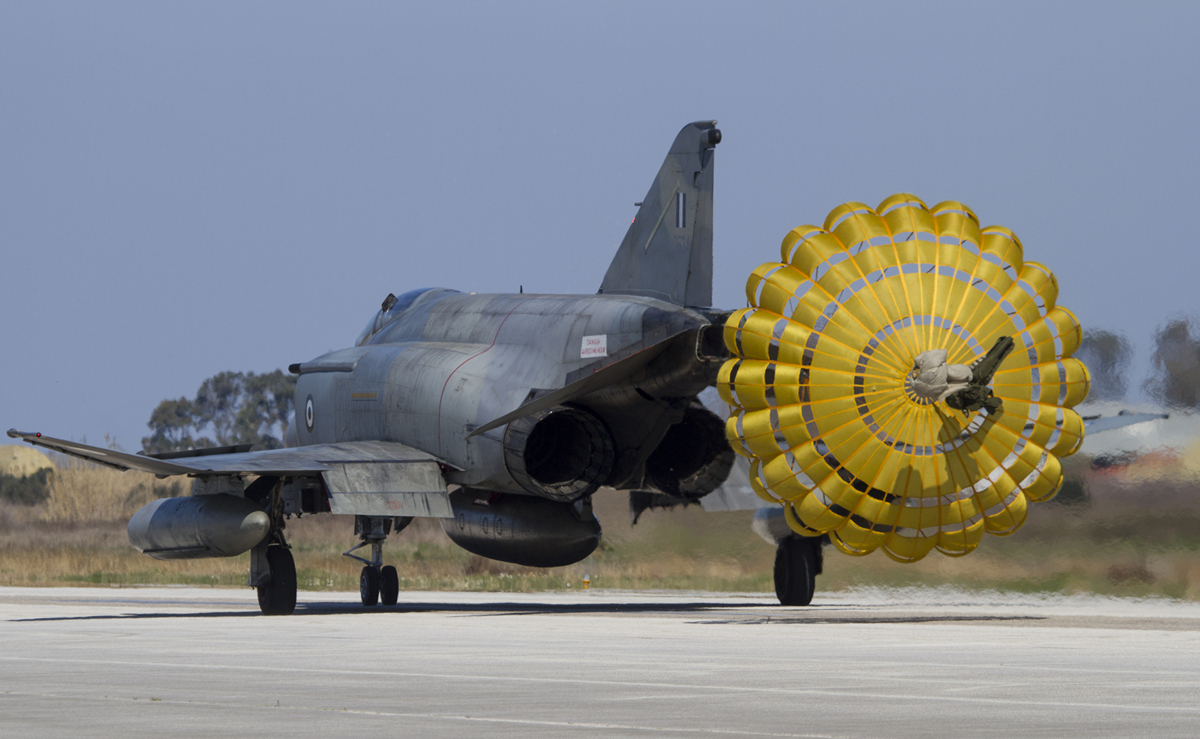
Click on an image below to page or swipe through the gallery:


